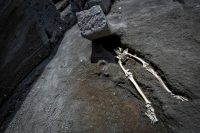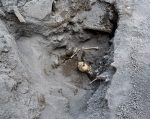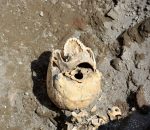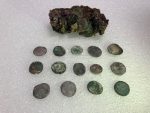 When the skeletal remains of a man were found with a large stone block where his skull and neck should be in excavation of the Regio V area of Pompeii, archaeologists hypothesized that he had been killed when when the pyroclastic flow of superheated volcanic gasses shot the 660-stone at him, striking his upper thorax and head and pinning him to the ground. The image gave rise to many Wile E. Coyote references with Vesuvius playing the role of the Roadrunner.
When the skeletal remains of a man were found with a large stone block where his skull and neck should be in excavation of the Regio V area of Pompeii, archaeologists hypothesized that he had been killed when when the pyroclastic flow of superheated volcanic gasses shot the 660-stone at him, striking his upper thorax and head and pinning him to the ground. The image gave rise to many Wile E. Coyote references with Vesuvius playing the role of the Roadrunner.
 Now everyone who made those Acme-brand japes is going to have to take them back, because the man’s skull and bones from his upper body have been found and they’re intact. He wasn’t killed by a giant stone being dropped on him after all.
Now everyone who made those Acme-brand japes is going to have to take them back, because the man’s skull and bones from his upper body have been found and they’re intact. He wasn’t killed by a giant stone being dropped on him after all.
 The excavations at the corner of the Alley of the Balconies and the Alley of the Silver Wedding where the lower body was found unearthed a tunnel underneath it. The tunnel likely dates to the reign of the Bourbon kings of Naples in the 18th century when Pompeii was first “excavated,” to use the term loosely. King Charles III of Naples’ interest in funding these explorations was largely informed by the hope of acquiring fine ancient artifacts for his collection. Destroying structures mattered not one whit to him, so disturbing human remains didn’t even rank notice.
The excavations at the corner of the Alley of the Balconies and the Alley of the Silver Wedding where the lower body was found unearthed a tunnel underneath it. The tunnel likely dates to the reign of the Bourbon kings of Naples in the 18th century when Pompeii was first “excavated,” to use the term loosely. King Charles III of Naples’ interest in funding these explorations was largely informed by the hope of acquiring fine ancient artifacts for his collection. Destroying structures mattered not one whit to him, so disturbing human remains didn’t even rank notice.
 This particular tunnel eventually caved in, and the top part of the body, formerly articulated with the rest of the skeleton above the pumice layer, slid into the cavity. The tunnel didn’t extend under the block so the stone and the bottom section of the skeleton remained in their original positions, supported by the hardened pumice layer.
This particular tunnel eventually caved in, and the top part of the body, formerly articulated with the rest of the skeleton above the pumice layer, slid into the cavity. The tunnel didn’t extend under the block so the stone and the bottom section of the skeleton remained in their original positions, supported by the hardened pumice layer.
His death was presumably not, therefore, due to the impact of the stone block, as initially assumed, but likely to asphyxia caused by the pyroclastic flow. The identified skeletal remains consist of the upper part of the thorax, the upper limbs, the skull and jaw. Currently undergoing analysis, they display some fractures, the nature of which will be identified, so as to be able to reconstruct the final moments in the life of the man with greater accuracy.
 Earlier this month, archaeologists found another piece of this poor soul’s puzzle: his hasty escape kit. A small leather pouch was discovered under his lower body. It contained 20 silver coins and an iron key. The key was likely his house key, an artifact that bears sad witness to the expected homecoming he and so many others would be brutally denied. The coins were worth a total of 80 sestertii, the equivalent of about $600, enough money for the average Roman family to live on comfortably for two weeks. The amount of cash he had on him suggests he was neither a wealthy man nor a poor one.
Earlier this month, archaeologists found another piece of this poor soul’s puzzle: his hasty escape kit. A small leather pouch was discovered under his lower body. It contained 20 silver coins and an iron key. The key was likely his house key, an artifact that bears sad witness to the expected homecoming he and so many others would be brutally denied. The coins were worth a total of 80 sestertii, the equivalent of about $600, enough money for the average Roman family to live on comfortably for two weeks. The amount of cash he had on him suggests he was neither a wealthy man nor a poor one.
The skeletal remains, the leather purse and the coins are now in a laboratory where they will be conserved and studied to shed light on the man and the events that overtook him more than 1900 years ago.
DRATS! BAMBOOZLED AGAIN!
Can I believe in nothing anymore?!!??
Did you know that a stone of 660 stones equals an equivalent of 153.634,2 Roman “unciae” (i.e. Roman ounces)?
As it turnes out now, the poor chap was slowly rocked and rolled, being volcanically drugged, and, (here we need more in depth research) in the ‘Alley of the Silver Wedding’ he was sexed (up).
Altogether, I dare say, quite a ‘post mortem'(!) achievement that -I reckon- even experts like Keith Richards might be unable to beat :notworthy:
Oh well, so much for my planned meme: ‘Never look back!’